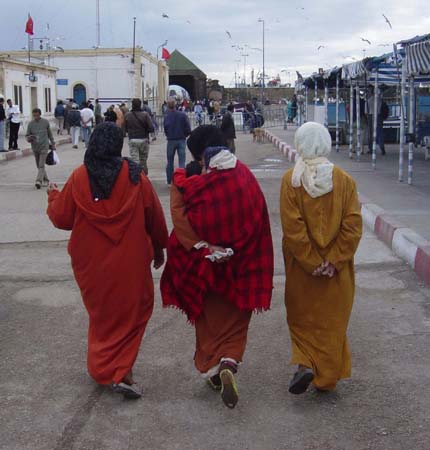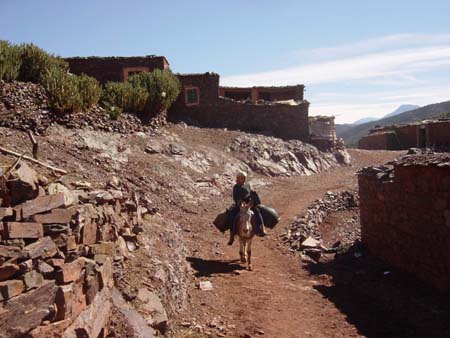Monday, October 27
Paula: We left Marrakech today and drove to Essaouira,
a small fishing town on the Atlantic coast. Essaouira had been recommended
as a good change of pace from Marrakech - it still has its own Medina and
souqs, but is much smaller and quieter. The road to Essaouira is basically
a straight line west from Marrakech, but is nothing like we have been on before.
The two lanes are treated like three, with one "unmarked" passing
lane in the middle that serves either direction. Basically, you can pass anytime
and  when
you are being passed you are expected to pull over on the shoulder. This becomes
essential because the road is frequented by donkeys, carts, bikes, pedestrians,
cars and trucks with huge (and very unbalanced) loads.
when
you are being passed you are expected to pull over on the shoulder. This becomes
essential because the road is frequented by donkeys, carts, bikes, pedestrians,
cars and trucks with huge (and very unbalanced) loads. 
What on a map looked like a boring drive was fascinating to us. Once outside
of Marrakech, we could see that the lands on both sides of the road were flat,
desert-like plains with mountains in the distance. Every few miles, we passed
small villages that were initially almost undetectable because their low profile
and color blended into the dirt. We saw small children walking long distances
to school and people making their way to villages with open markets. We drove
through several of the markets and admired the colorful crowds. There were
also many shepherds herding sheep and goats, sometimes right along the road.
We often wondered what the livestock were eating because all we could see
was dirt. As we got closer to Essaouira, the landscape began to change. The
desert became more co ntoured
and gradually we began to see more vegetation and even orchards of olive and
orange trees.
ntoured
and gradually we began to see more vegetation and even orchards of olive and
orange trees. 
After checking in and having a nice lunch at our hotel, we walked along the beach. From the waterfront, it's possible to see much of the town and its buildings. This is very different than Marrakech - all the buildings are white with bright blue shutters instead of the red clay color of everything in Marrakech. The ocean is a chocolate brown due to the choppy waters that are churned by the constant strong winds here. There were many wind and kite surfers taking advantage of the conditions, but we wondered how many people swim in the surf during the warmer months. The muddy color of the water doesn't look very attractive to us. The beach is sandy and it seemed unusual to see men in traditional dress walking along the surf.
 We
walked to the fishing port located just outside the walls of the Medina. The
port was bustling with activity and quite colorful. There were many large
fishing boats in the harbor, many having just dropped off their daily catch,
and there were hundreds of small fishing boats all in the Essaouira blue color.
We saw boats being repaired and constructed as well as men sewing nets and
baiting hooks. There were many men negotiating for the sale of today's catch,
as well as small markets with fish for sale. A very common fish here is
We
walked to the fishing port located just outside the walls of the Medina. The
port was bustling with activity and quite colorful. There were many large
fishing boats in the harbor, many having just dropped off their daily catch,
and there were hundreds of small fishing boats all in the Essaouira blue color.
We saw boats being repaired and constructed as well as men sewing nets and
baiting hooks. There were many men negotiating for the sale of today's catch,
as well as small markets with fish for sale. A very common fish here is  something
very long that looks almost like an eel - we want to find out what kind of
fish this is, since we've never seen anything like it at home.
something
very long that looks almost like an eel - we want to find out what kind of
fish this is, since we've never seen anything like it at home.
 The
Medina was equally fun, and is much smaller and therefore more manageable
than the one in Marrakech. The streets are also a bit wider and don't allow
cars or bikes, making it considerably safer. We enjoyed visiting the woodcarving
workshops and made some wonderful purchases. Essaouira is known for its woodcarving
and they use the trunks and roots of the juniper tree. We also decided to
buy a small tea set because we have fallen in love with Moroccan mint tea.
This sweet tea is served in small glasses and metal tea pots. I'm not sure
how we will ever get all these things back to the states.
The
Medina was equally fun, and is much smaller and therefore more manageable
than the one in Marrakech. The streets are also a bit wider and don't allow
cars or bikes, making it considerably safer. We enjoyed visiting the woodcarving
workshops and made some wonderful purchases. Essaouira is known for its woodcarving
and they use the trunks and roots of the juniper tree. We also decided to
buy a small tea set because we have fallen in love with Moroccan mint tea.
This sweet tea is served in small glasses and metal tea pots. I'm not sure
how we will ever get all these things back to the states. 
Today was the beginning of Ramadan and the markets were busy in the afternoon as everyone was preparing to "break the fast" at 6:00 PM. Ramadan lasts for 28 days, and during this time Muslims are not allowed to eat, drink or smoke between the hours of sunrise and sunset. We had heard that people get a bit agitated at the beginning of the holiday, particularly because it is difficult to not smoke. The lack of smoking was very evident and we also noticed that while locals sat in the cafes, they were not eating or drinking. All this changed as soon as the sun set. Once the call to prayers was complete, a siren went off in the town and immediately everyone began eating and drinking in cafes and along the streets. While most of the shops closed just before 6:00, people sat together eating in those that were still open. As soon as the siren sounded, people actually smiled at us and gave us thumbs up signs, clearly happy that the first feast was about to begin. We also saw many men praying in the small mosques in the medina. We felt fortunate to be here during Ramadan.
We took several pictures of the colorful fishing harbor today, and have included the best of these below. Tomorrow we'll probably head back into the port and the Medina again. We also want to relax at our hotel, and may take advantage of the hammam that's located here.
Distance Walked: 1.39 miles








Katie's Komments
The topic for today is…My impressions of a hilltop Berber village
This week we visited a small Berber village on the side of a red ochre hill. We expected to find some nice views of the mountains and learn a little about the homes of these people. However, this experience ended up meaning much, much more.
As we walked up the steep clay hill, we were immediately accompanied by children. At first we ignored them, thinking they were only spying on us to see what foreigners might be doing in their tiny village. As our guide taught us about the village, however, we began to understand how hard the lives of these children are. We learned that the entire village, with a population of 160 people, had no electricity or running water. This requires the children to work hard with their families to bring water from the river up to their homes on donkeys. We also learned that there are very few markets in the village. This requires the families to buy things from markets in other villages, which can sometimes be several hours away, and load them on the backs of donkeys. There are also woman from other villages on donkeys delivering gasoline for cooking and sometimes water for drinking.
 As
we continued up the hill we saw many people bringing water jugs and other
supplies up and down on donkeys. We also saw women by the river down below
washing their clothes. This seemed to us like a pretty difficult life, but
fortunately none of the children looked like they were starving or poorly
dressed. When they asked for coins it was very playfully, and we found it
amusing to watch them call over their other friends and show off their prizes.
As more and more children joined, our coins began to dwindle away and we felt
horrible when we found that there wa
As
we continued up the hill we saw many people bringing water jugs and other
supplies up and down on donkeys. We also saw women by the river down below
washing their clothes. This seemed to us like a pretty difficult life, but
fortunately none of the children looked like they were starving or poorly
dressed. When they asked for coins it was very playfully, and we found it
amusing to watch them call over their other friends and show off their prizes.
As more and more children joined, our coins began to dwindle away and we felt
horrible when we found that there wa sn't
enough for everyone. We gave them anything we had left including one of our
ballpoint pens. When all was gone, the large group of children tagged along
jumping up and down in excitement, hoping for more.
sn't
enough for everyone. We gave them anything we had left including one of our
ballpoint pens. When all was gone, the large group of children tagged along
jumping up and down in excitement, hoping for more.
In the end we gave them a 20 Dirhan bill to split between everyone. In exchange we could take there photograph. As the children ran off in pleasure and satisfaction, we knew that we had made some new friends. They lived very different lives than us yet we could both be happy, playful and sometimes even cocky. This was a wonderful experience that I will surely not forget..
